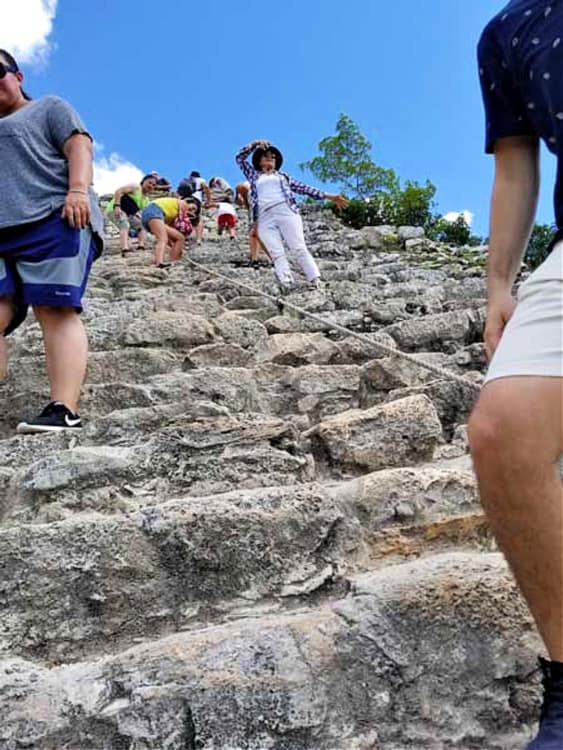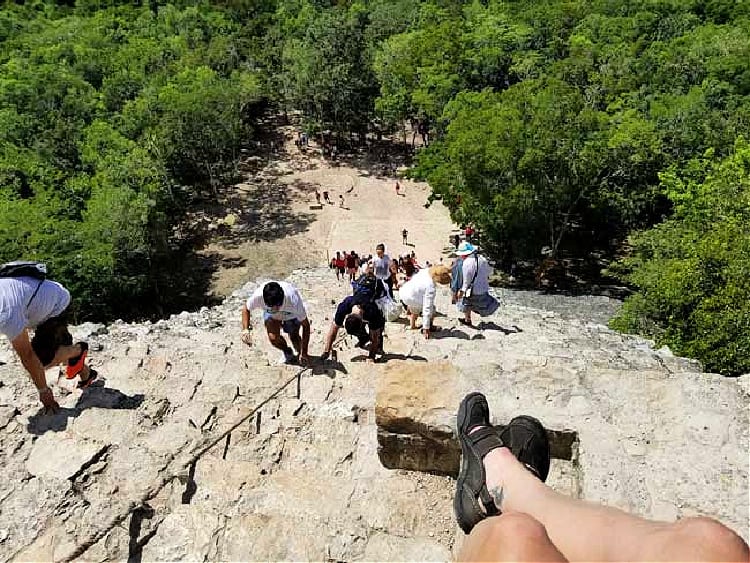
Mexico is a tropical paradise, but besides its beaches, this country offers an abundance of Mayan ruins to explore. The tiny Mayan village of Cobá, Mexico, is well worth adding to your travel list. Its awe-inspiring ruins offer an insight into the ancient Mayan city of Coba.
Cobá, Mexico

“To the Mayan, all that exists of the material world is all two sides of the same unit. Everything is double, but part of the same, like two sides of a coin. Maya means illusion because the human being lives in the manifestation of its own beliefs. What we believe is what we became and what we believe is expressed in our reality. Welcome to Maya!”
With those words, our guide, Alejandro Gamboa, introduces us to the ancient Mayan city of Cobá, once a thriving metropolis of 50,000 people near the Yucatan peninsula. While Cobá is well known among archaeologists, the place is not as well known to travelers.
Located just over two hours southwest from Cancun, Mexico, Cobá is one of those intriguing Mayan ruins, hidden in Quintana Roo’s inland jungle, but beach travelers to the Riviera Maya will find it an intriguing place to explore.
Grupo Cobá Mexico Ruins
Highway 109 from Tulum is the only paved road to Cobá and ends in a parking lot next to Lake Cobá with a few small shops, cafes, and a zipline. The area’s only public restrooms are here as well.
Our guide Gamboa motions us to follow him through an archway to a sign with a map of Cobá all in Spanish below the shade of a giant tree. He explains that Coba means “murky water” so named because Lake Coba is filled with sediment. He then leads us to the first group of buildings, Grupo Cobá.
Get more opportunities out of your trip to Mexico by learning Spanish before you go with Babbel. With customized lessons for any level that you can fit around your schedule, learning the language is simple and fun. Check out the Spanish lesson plan options here.
Gamboa tells us that the first white explorer here was German Teobert Maler in 1876, who photographed the site. Excavation did not happen until after the 1923 revolt against the Spanish when Pennsylvania University sent British archeologist Sir Eric Thompson and Mexican archeologist Dr. Pedro Rosa.
Thompson would return many times throughout his years of Mayan study because unlike other Mesoamerican sites, Cobá was still inhabited by a small local population.
Through those locals, Thompson made discoveries about the Mayan civilization that are still being examined today. Those findings include the Mayan Long Calendar and their extraordinary knowledge of astronomy.
More from tour guide Gamboa:
“Mayan art was born as a way of transmitting memory and wisdom. For Mayan people, the decline of the aristocracy polarized the society and this will generate war. Since war may interrupt the traditional way of transmitting memory and wisdom, they filled this place with knowledge – Arithmetic, Astronomy, Geometry, Mathematics, Cosmology, History. They said at the end of time, the splendor of these ancient cities will return and all this knowledge will be given back to mankind. They never said that the world was coming to an end on December 23, 2012. It is merely when the calendar wheels set back to zero.”

La Iglesia
My gaze follows Gamboa’s arm as he points to the tall, dark stone pyramid in front of us. He says when Sir Thompson explored here, he observed locals practicing rituals at the base of the structure so he named it La Iglesia, The Church.
“The priests pray midnight, sunrise, noontime, and sunset, four times a day. So as there are four directions of the world, four seasons, and four elements, they believe that each moment of the day, of a year, of an age, is ruled by each of this. For the year, the winter solstice is midnight, spring equinox is sunrise, noontime is the summer solstice, and sunset the equinox of the fall.”
Gamboa tells us the next group of structures is about a half kilometer away and we can rent bikes to cover the distance or hire a tricycle taxi to peddle us there. One person in our group opts for the taxi while the rest of us rent bicycles that appear old but are brightly painted.
My vibrant pink bike has the number 83 on the head tube. Gamboa says the numbers are so we can find our bikes among the dozens of people who park along the passageways as they traverse the site. He adds it’s quite common for someone to mistake your bike for theirs, especially if they are the same color, so the numbers help.
Doing the Math

With Gamboa leading the way we peddled a wide, flat pebbled path to Grupo D.
“They figured out that creation is septenary because the light has seven colors, the sound has seven notes and there were seven planets that make up the layers of the sky. We have the triangle and the square in reference of this seven. This square represents four worlds. Since there are four worlds, then we have twenty. See?”
No, I don’t, I think to myself.
“Five on north, five on east, five on south and five on west. Twenty, thirteen, and seven. Twenty steps to the place where the rulers sit. Why is that? Twenty is the way they actually kept track of time and they track eighteen months a year. The sun breathes eighteen times in a year. Human beings breathe eighteen times a minute. The heart of the earth beats four times, every time the sun breathes, just as our heart beats four times every time we breathe. Seventy-two years, 25,920 days. Seventy-two years the sun moves one degree in its procession. To complete a great day, the sun takes 25,920 years. There are 1440 minutes in one day, so we breathe 25,920 times. Small, big, it’s all the same.”
Did you follow all that?
What is Stele?

Gamboa motions us near a cluster of half walls, centered beneath a cover of palm fronds stands a monolith.
Called a stele, (stelae – pl), they are scattered throughout Cobá. Carved into them are Mayan hieroglyphics that name rulers and historical events that happened during the period they were created.
Gamboa says stelae were erected every twenty years to remind anyone who came after, what happened before and 47 stelae have been uncovered so far.
In 1993, epigrapher Linda Schele deciphered the glyphics of Stele 1 showing they contain the entirety of the Mayan creation myth, which was a huge find for archeologists and helped to define the complexity of the Mayan Long Calendar.
Returning to our bikes, we head a half kilometer north to Grupo Nohoch Mul and Cobá’s tallest structure.
“The longest night of the year is the winter solstice, but at the end is the end as well as the beginning. I cannot say what is actually going to be happening, but there is going to still happen a lot of things. So December 23, 2012, as I said, is not the end. There are 120 steps and a sign that says climbing is at your own risk.”
Climbing the Nohoch Mul Pyramid

With that, we are free to climb the imposing Nohoch Mul pyramid, taller than El Castillo at Chichen Itza. The pyramid and surrounding structures were built around the 7th Century, the height of Cobá’s influence in the region.
It isn’t until you take the first step that you realize how difficult climbing is. The steps are narrow in width and tall in height, the opposite of the steps we have today.
Many travelers scoot up and down the steep structure on their rear ends and two people in our group opt not to climb for fear of heights.

My advice for climbing?
Take your time. Something else to make it easier is to face either side, not straight on, and sidestep your way up and down. Running the length of the pyramid is an attached rope for people to hold.
Make sure you pack a pair of reliable hiking shoes! Whether you want a pair of durable boots or more relaxed nature sandals, Sierra Trading Post has everything you need to make it to the top of the pyramid comfortably. Find more hiking shoes and clothing here.
In the hot midday sun climbing is strenuous, but worth it because at the summit are endless views of the surrounding jungle, nothing but green treetops for miles.
My view revealed no signs of civilization, not even the other structures or Lake Cobá. Is this how it looked during the date inscribed on nearby Stele 30? This date corresponds to our calendar as of November 30, 780 AD.
“This is the spiritual life force that Mayas measure 13×20 because 260 days is the average time of human gestation, the rainy season, and the regular cycle of corn. A period of divine manifestation that gets repeated once every 52 years. Fifty-two years is the time that the planets take to be in the same place in the sky. The governors of destiny. They figured out that the movements of [planets] in the sky match perfectly with climatic changes, seasonal germination, and the growing powers of nature. They have a link, a mathematical equation. It’s how Maya was able to figure out the cosmos.“

If You Visit the Cobá Ruins
Rumors abound that Cobá will end climbing Nohoch Mul because of the dangers and footsteps degrading the structure.
My feelings are mixed about this development. To see the jungle from the summit is an amazing experience, but with hundreds of people climbing every day, accidents and damage will happen.
Bottom line? If you wish to climb the Coba pyramid, get there soon. Wear comfortable walking and bike riding shoes and bring water because it gets hot in the afternoon. Sunscreen and a hat are also useful.
Hire local guides at the entrance. Be sure the guide has an official Cobá lanyard and badge to get the best rates and knowledge. Arrange tours through area resort concierges. Avoid visiting the ruins on Sundays as it’s free admission to Mexican citizens and can be very crowded.
Book This Trip
Ready to start exploring one of the most beautiful and historical sights in Mexico? You’ll want to be prepared with plans for transportation, hotel or VRBO bookings and ofcourse, a little insider knowledge on interesting local shops and restaurants. For all this and more check out Travelocity and TripAdvisor.
Beyond the local tour guides at Cobá, you can find more private and unique tours all over Mexico through GetYourGuide. With their new cancellation policy, you can cancel your booking anytime before 24 hours of the tour so you can plan your trip stress-free. Secure your spot on one of these best-selling tours here.
